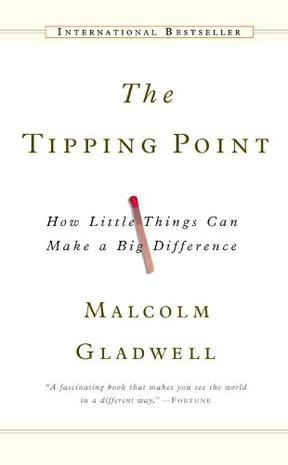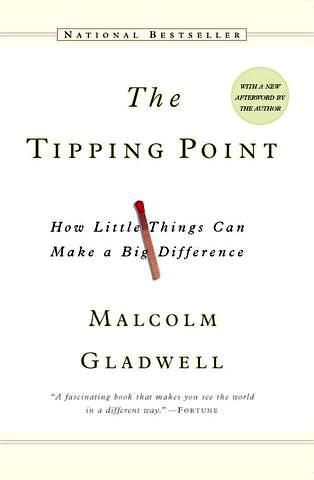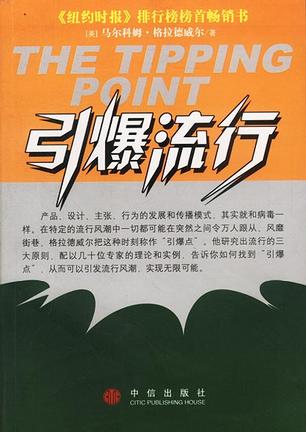欢迎来到相识电子书!
标签:流行
-
引爆趋势
《引爆趋势(经济读物)》内容简介:为什么会有成百上千万人最后选择穿同样的衣服?为什么嘻哈风潮总是和阿迪达斯球鞋密不可分?为什么啤酒的魅力下降,而葡萄酒却越来越受欢迎?为什么本世纪初各大汽车厂商又开始推出复古车型?为什么北欧的家具设计成为20世纪最经典的设计风格之一?为什么麦当娜的写真集成为广告人的灵感之源?为什么说雅痞一族改变了LV品牌的命运?iPod如何让苹果品牌死里逃生?为什么化妆品潮流传播最快,运动品牌最慢?好莱坞电影对趋势形成有怎样的推动力?为什么打“时尚牌”让Puma赶超了运动品牌巨头Nike?这个世界,谁在制造各领域的趋势?人们制造和追赶趋势的心理因素是什么?全球趋势从何处发端,又经由怎样的过程被全面引爆?在趋势成为主流的过程中,谁和什么是最大的幕后推手?如何将品牌融八趋势的演进中,成为趋势流中最大赢家? 这是一个被趋势裹挟的时代。你吃什么,你用什么数码产品,今年要买哪种冬装,一切都由趋势说了算。趋势不仅仅是时尚界的事,摸清趋势背后的秘密,让趋势为你所用,你也能成为引爆趋势的火种。 -
奇怪@壹
--=编辑推荐=-- 发现66个全球范围内最奇妙、最疯狂、最不为人知的创意网站! 一部互联网上上的爱丽丝漫游仙境!颠覆想象力、启发创造力、改变观察力。 从玩具旅行家到图书漂流站、一日一照到被恶搞的蒙娜丽莎、梦境粒子画家到危险实验室……跨越国界的创意网站推荐+创始人采访。充满天马行空想象力,换个角度看世界。 Google中国总裁李开复、21世纪报系发行人沈颢、资深广告人张小平、太美·全球主题旅行聚乐部总裁梁冬、香港民谣创作才子林一峰、《城市画报》副主编黎文6人邀赏推出。 结识同好 在充满好奇心的世界里游荡, 给永远不会疲倦和衰老的你。 --=内容简介=-- 一部互联网上的稀奇古怪网站大集合!推荐+采访全球66个最具创意、最不为人知、最有想象力的创意网站,创始人访谈、评述并推荐了他们独一无二的创意。 千奇百怪的网站,从搞怪网站、私人收藏、最聪明的商业点多媒体艺术家的严肃思考……它们中绝大多数的出发点只是个人兴趣,但也不乏有商业成功者。图文并茂,读起来也趣味横生,颠覆想象力、启发创造力、改变观察力! --=目录=-- 1 发梦的人请举手 玩具旅行家 嗨,发明家! 时空胶囊 你那边几点 疯狂的危险实验室 发掘电影背后的真实故事 百万格子 梦想成真 做一份自己的报纸 上班族的互助盒子 2 人人都是艺术家 梦境画家 这一刻 像地球一样自转360° 金钱语言 不用点击的网站 Ching&Co的中西混合风 无国界画廊 一日一照 畜牧帝国 10美元小组 每一秒的出生和死亡 英国创意市集 破盒而出,够力量就来 3 无厘头,有道理 我爱搞破坏! 谁比谁更强 杜威小姐的搜索服务 被恶搞的蒙娜丽莎小姐 死亡SPACE 猫无穷尽 有麻烦,问上帝! 匿名骚扰邮件 鬼脸王大集合 最长域名的网站 最高的虚拟大楼 世界上最小的网站 世界颠倒了 每个人都有的事是糗事 4 我要提问 我的小猪啥模样 图图测性格 测试网站的邪恶程度 安迪·沃霍尔的中国名字 在“鲍伯”的头像前祈祷 5 收藏成癖 世界尽头的电话亭 我为鞋狂 第一次世界大战的彩色照片 中国的宣传海报 我的初吻在哪里 1950的美国 办公室博物馆 云上的日子 鲑鱼网站 6 爱默生网站 账单和尚帮你理财 游戏上网两不误 我要提问 完美的自我推荐 图书漂流网 百度谷歌一起用 24格连拍 世物如何运作 猜LOGO 看,图说话 威客在中国 人立方 豆瓣胡同里的大客厅 译言新青年 --=媒体评论=-- 我们生活在充满创意的时代。新奇的思路,创造性的观点和创新的设计不断从身边的每个角落涌现出来。《奇怪》,汇集奇妙、非凡的网站创意,收录创意背后的动人故事,一本有趣的、有创意的书! ——Google中国总裁李开复 正如艺术家对于商业社会的价值,这些创意独特的网站追求的是思考、趣味和另外的方向。如果《奇怪》能够不断地出版下去,该有多好。 ——21世纪报系发行人沈颢 --=书摘插图=-- 1 发梦的人请举手 玩具旅行家 什么是ToyVoyagers ToyVoyagers是一个让玩具进行旅行和冒险的网站,完全免费加入。我们有一个友好的国际社区,提供ID号和激活码让你在旅行中的玩具变成玩具旅行家,在网站上有一个简历介绍页面,使用网站博客系统记录旅行博客。 …… -
流行音乐文化
影印版 -
The Tipping Point
Book Description This celebrated New York Times bestsellernow poised to reach an even wider audience in paperbackis a book that is changing the way North Americans think about selling products and disseminating ideas. Gladwells new afterword to this edition describes how readers can constructively apply the tipping point principle in their own lives and work. Widely hailed as an important work that offers not only a road map to business success but also a profoundly encouraging approach to solving social problems. Amazon.com "The best way to understand the dramatic transformation of unknown books into bestsellers, or the rise of teenage smoking, or the phenomena of word of mouth or any number of the other mysterious changes that mark everyday life," writes Malcolm Gladwell, "is to think of them as epidemics. Ideas and products and messages and behaviors spread just like viruses do." Although anyone familiar with the theory of memetics will recognize this concept, Gladwell's The Tipping Point has quite a few interesting twists on the subject. For example, Paul Revere was able to galvanize the forces of resistance so effectively in part because he was what Gladwell calls a "Connector": he knew just about everybody, particularly the revolutionary leaders in each of the towns that he rode through. But Revere "wasn't just the man with the biggest Rolodex in colonial Boston," he was also a "Maven" who gathered extensive information about the British. He knew what was going on and he knew exactly whom to tell. The phenomenon continues to this day--think of how often you've received information in an e-mail message that had been forwarded at least half a dozen times before reaching you. Gladwell develops these and other concepts (such as the "stickiness" of ideas or the effect of population size on information dispersal) through simple, clear explanations and entertainingly illustrative anecdotes, such as comparing the pedagogical methods of Sesame Street and Blue's Clues, or explaining why it would be even easier to play Six Degrees of Kevin Bacon with the actor Rod Steiger. Although some readers may find the transitional passages between chapters hold their hands a little too tightly, and Gladwell's closing invocation of the possibilities of social engineering sketchy, even chilling, The Tipping Point is one of the most effective books on science for a general audience in ages. It seems inevitable that "tipping point," like "future shock" or "chaos theory," will soon become one of those ideas that everybody knows--or at least knows by name. --Ron Hogan From Publishers Weekly The premise of this facile piece of pop sociology has built-in appeal: little changes can have big effects; when small numbers of people start behaving differently, that behavior can ripple outward until a critical mass or "tipping point" is reached, changing the world. Gladwell's thesis that ideas, products, messages and behaviors "spread just like viruses do" remains a metaphor as he follows the growth of "word-of-mouth epidemics" triggered with the help of three pivotal types. These are Connectors, sociable personalities who bring people together; Mavens, who like to pass along knowledge; and Salesmen, adept at persuading the unenlightened. (Paul Revere, for example, was a Maven and a Connector). Gladwell's applications of his "tipping point" concept to current phenomena--such as the drop in violent crime in New York, the rebirth of Hush Puppies suede shoes as a suburban mall favorite, teenage suicide patterns and the efficiency of small work units--may arouse controversy. For example, many parents may be alarmed at his advice on drugs: since teenagers' experimentation with drugs, including cocaine, seldom leads to hardcore use, he contends, "We have to stop fighting this kind of experimentation. We have to accept it and even embrace it." While it offers a smorgasbord of intriguing snippets summarizing research on topics such as conversational patterns, infants' crib talk, judging other people's character, cheating habits in schoolchildren, memory sharing among families or couples, and the dehumanizing effects of prisons, this volume betrays its roots as a series of articles for the New Yorker, where Gladwell is a staff writer: his trendy material feels bloated and insubstantial in book form. Agent, Tina Bennett of Janklow & Nesbit. Major ad/promo. (Mar.) From Library Journal This genial book by New Yorker contributor Gladwell considers the elements needed to make a particular idea take hold. The "tipping point" (not a new phrase) occurs when something that began small (e.g., a few funky kids in New York's East Village wearing Hush Puppies) turns into something very large indeed (millions of Hush Puppies are sold). It depends on three rules: the Law of the Few, the Stickiness Factor, and the Power of Context. Episodes subjected to this paradigm here include Paul Revere's ride, the creation of the children's TV program Sesame Street, and the influence of subway shooter Bernie Goetz. The book has something of a pieced-together feel (reflecting, perhaps, the author's experience writing shorter pieces) and is definitely not the stuff of deep sociological thought. It is, however, an entertaining read that promises to be well publicized. Recommended for public libraries. -Ellen Gilbert, Rutgers Univ. Lib., New Brunswick, NJ From Booklist Gladwell, a New Yorker staff writer, offers an incisive and piquant theory of social dynamics that is bound to provoke a paradigm shift in our understanding of mass behavioral change. Defining such dramatic turnarounds as the abrupt drop in crime on New York's subways, or the unexpected popularity of a novel, as epidemics, Gladwell searches for catalysts that precipitate the "tipping point," or critical mass, that generates those events. What he finds, after analyzing a number of fascinating psychological studies, is that tipping points are attributable to minor alterations in the environment, such as the eradication of graffiti, and the actions of a surprisingly small number of people, who fit the profiles of personality types that he terms connectors, mavens, and salesmen. As he applies his strikingly counterintuitive hypotheses to everything from the "stickiness," or popularity, of certain children's television shows to the spread of sexually transmitted diseases, Gladwell reveals that our cherished belief in the autonomy of the self is based in great part on wishful thinking. Donna Seaman From AudioFile Why is it that fashion trends change the way we dress? Why do various TV shows, movies, and books become so popular? Malcolm Gladwell provides a diagram of our society, along with an analysis of the strategies people apply to influence and mold its direction. Gladwell describes the personality types that create trends and those that influence others by "spreading the word." History takes on a whole new perspective as he describes events of early America that specifically follow his theories of "selling the public on an idea" and "social epidemics." Feedback from market mavericks further substantiates Gladwell's viewpoints. B.J.P. Book Dimension length: (cm)17.2 width:(cm)10.8 点击链接进入中文版: 引爆点 -
造型之书
《造型之书》中形象设计师徐银暎将不可多得的美灵性捕捉,顶级模特张允柱将无与伦比的美自然呈现,两位韩国女性联手奉献造型秘籍。韩国一流形象设计师徐银暎和顶级模特张允柱,讲述属于这个时代的造型故事。两位时尚专家将所有的造型经验与读者分享,帮你在生活中找到属于自己的造型方式,打造自己的造型风格。 第一次和男朋友去看电影时,我穿了黑色连衣裙和Mary Jane的鞋。出门之前我在家里试穿了十来套衣服,最后决定采用经典简单的造型。我想让他觉得我是个精致而温柔的女孩。 而当我前去参加期待已久的Win设计室的面试时,我穿了长裙和黑上衣,戴了GLJCCI的黑框眼镜,擦了香奈儿的44号口红,头上还戴了天鹅绒质地的发带。我心情紧张地在家里试穿了不下十套衣服,最后决定用这个无可挑剔而又具个性的装扮去面试。 去见前任男友时,我穿了索菲亚。可可萨拉凯(S0phia Kokosalaki)的黑色低领连衣裙,配上象牙雕花项链。我怀着忐忑不安的心情试穿很多套衣服,最后决定给他温柔而充满女性美的感觉。因为我想让他看到我成熟稳重、不再尖锐的样子。 在你恋爱时,分手时,想同期待已久的人共事时,甚至是你想尽情放松时,你的心情和内心所想都会体现在你的外表上。 造型并不是要一味地追求时下流行的元素,昂贵的名品也不能等同于造型风格。造型应该是梦想,是快乐。想象你自己希望的样子,将自己装扮成那个样子并享受那一瞬间的惊喜,你就能拥有属于你的造型风格,并会发现人生的快乐。美并没有一个标准,只要充满自信,勇敢地表现自己就是美。造型和爱情都要拥有自信才能够得到。 -
The Tipping Point
"The best way to understand the dramatic transformation of unknown books into bestsellers, or the rise of teenage smoking, or the phenomena of word of mouth or any number of the other mysterious changes that mark everyday life," writes Malcolm Gladwell, "is to think of them as epidemics. Ideas and products and messages and behaviors spread just like viruses do." Although anyone familiar with the theory of memetics will recognize this concept, Gladwell's The Tipping Point has quite a few interesting twists on the subject. For example, Paul Revere was able to galvanize the forces of resistance so effectively in part because he was what Gladwell calls a "Connector": he knew just about everybody, particularly the revolutionary leaders in each of the towns that he rode through. But Revere "wasn't just the man with the biggest Rolodex in colonial Boston," he was also a "Maven" who gathered extensive information about the British. He knew what was going on and he knew exactly whom to tell. The phenomenon continues to this day--think of how often you've received information in an e-mail message that had been forwarded at least half a dozen times before reaching you. Gladwell develops these and other concepts (such as the "stickiness" of ideas or the effect of population size on information dispersal) through simple, clear explanations and entertainingly illustrative anecdotes, such as comparing the pedagogical methods of Sesame Street and Blue's Clues, or explaining why it would be even easier to play Six Degrees of Kevin Bacon with the actor Rod Steiger. Although some readers may find the transitional passages between chapters hold their hands a little too tightly, and Gladwell's closing invocation of the possibilities of social engineering sketchy, even chilling, The Tipping Point is one of the most effective books on science for a general audience in ages. It seems inevitable that "tipping point," like "future shock" or "chaos theory," will soon become one of those ideas that everybody knows--or at least knows by name. --Ron Hogan, Amazon.com -
台湾流行音乐200最佳专辑(1975~2005)
《台湾流行音乐200:最佳专辑(1975-2005)》内容简介:我的母亲陶晓清是资深广播人,打从1970年代便是美国权威音乐杂志《滚石》(Rolling Stone)的订户。父母卧室的床头和地上,常常摊着他们读到一半的书。父亲那边是杂文、小说、古籍;母亲这边,枕头底下便经常压着一本《滚石》。我自己是到上了中学,认真听起摇滚乐,才慢慢感觉《滚石》的厉害。尽管以我当时的英文程度和音乐知识,大多文章只能半读半猜,却也很长了不少见识。 1987年,信箱收到一本特别厚的《滚石》特刊:他们广邀各方乐评,选出1967年以来最伟大的一百张专辑,作为创刊二十周年特别企划。当年自然没有网络这种东西,此类资讯极为珍罕,消息传播也远不如现在迅速,这份“百碟榜”的效应,竟持续了好几年:若干台湾杂志曾经抄列这份榜单,唱片行也常把它张贴在店头,作为顾客采购指南。一时之间,自诩精进的乐迷人手一份,人人都在盘点自己听过几张,仿佛那是一份“摇滚学力测验”的考卷。 -
引爆流行
马尔科姆·格拉德威尔以社会上突如其来的流行风潮研究为切入点,从一个全新的角度探索了控制科学和营销模式。他认为,思想、行为、信息以及产品常常会像传染病爆发一样,迅速传播蔓延。正如一个病人就能引起一场全城流感;如果个别工作人员对顾客大打出手,或几位涂鸦爱好者管不住自己,也能在地铁里掀起一场犯罪浪潮;一位满意而归的顾客还能让新开张的餐馆座无虚席。这些现象均属“社会流行潮”,它爆发的那一刻,即达到临界水平的那一刻,就是一个引爆点。 格拉德威尔走访了宗教团体、成功的高科技公司以及全球最优秀的推销员,他在书中分析了几种有利于开创流行风潮的性格特征,剖析了种种极具感染力的事件,如各种风尚、吸烟现象、儿童电视、商业邮寄广告等,并阐明其背后的导火索。通过大量深具说明力的研究,揭示出发起流行潮并保持其势头的原则和方法。
热门标签
下载排行榜
- 1 梦的解析:最佳译本
- 2 李鸿章全传
- 3 淡定的智慧
- 4 心理操控术
- 5 哈佛口才课
- 6 俗世奇人
- 7 日瓦戈医生
- 8 笑死你的逻辑学
- 9 历史老师没教过的历史
- 10 1分钟和陌生人成为朋友









